Semiya Payasam is a South Indian sweet dish made with roasted vermicelli (semiya), milk, sugar, and flavored with cardamom. It is often garnished with cashews and raisins fried in ghee. Creamy, sweet, and fragrant, it’s commonly prepared during festivals and special occasions. Here, I have shared both stovetop and Instant Pot methods for making this lovely dessert.
About Semiya Payasam
There are many dishes in Indian cuisine that have their regional variations. One such sweet dish is a milk-based pudding, or Kheer of North India. Which, becomes the payasam in South India.
In this post, I have shared a decadent Semiya Payasam recipe from the South Indian cuisine. Also known as Vermicelli Payasam, it is a sweet, creamy pudding made with semiya/seviyan or vermicelli, milk and some more ingredients.
In South Indian languages, ‘semiya’ means ‘vermicelli’ and ‘payasam’ is a sweetened pudding made with either milk or coconut milk.
Hence, the name Semiya Payasam. In English, this translates to vermicelli pudding, which is made by cooking roasted/fried vermicelli in milk and finished with sugar and ghee-fried nuts, dry fruits.
This Vermicelli Payasam literally has just 7 ingredients in the recipe, which are also easily available at any Indian home kitchen.
Making this payasam recipe does not take much time and is quite simple too. Yet, supremely delicious when you want to savor an Indian dessert.
This cardamom scented Semiya Payasam comes together in 20 minutes and can be made by beginners too. Being so easy, you can make it any day when you fancy something sweet or for any festive or religious occasion.
Choosing The Right Vermicelli
Since vermicelli or semiya is the star ingredient in this Vermicelli Payasam, its obvious that you should be careful in choosing the right variety for your dish.
In Indian markets, one finds different kinds of vermicelli made with various cereal flours. Usually, this payasam recipe is made with wheat flour or rice flour vermicelli.
However, you can make this Semiya Payasam with all-purpose flour (maida), ragi (finger millet) or rava/suji (cream of wheat) vermicelli too.
For health reasons, I prefer to use semiya made from whole wheat flour, rice flour or ragi flour in my payasam recipe.
Step-by-Step Guide
How to make Semiya Payasam
Fry dry fruits
1. In a heavy pan or kadai, add 2 tablespoons ghee first. Let it melt. Then, add 12 to 15 cashews.
Tip: Do use a heavy pan or kadai (Indian wok) so that the nuts, vermicelli get cooked evenly and do not burn or turn black.
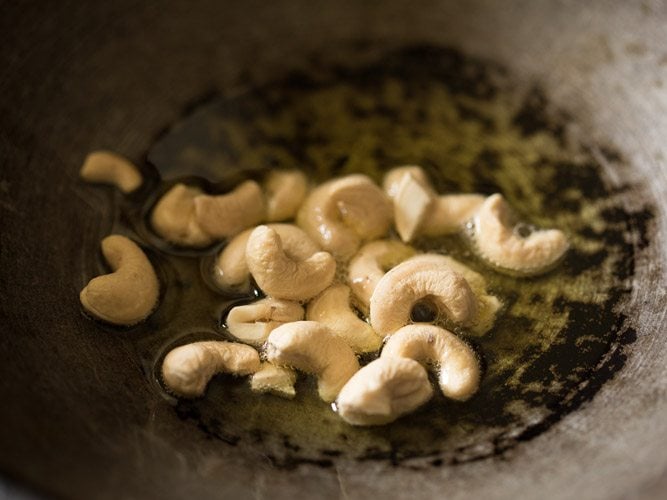
2. On low to medium heat, fry until the cashews turn golden.
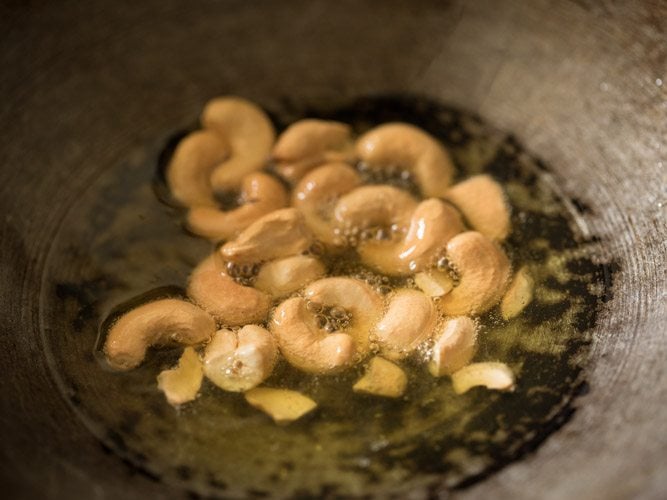
3. Remove the fried cashews with a slotted spoon and then add 1 tablespoon raisins to the hot ghee.
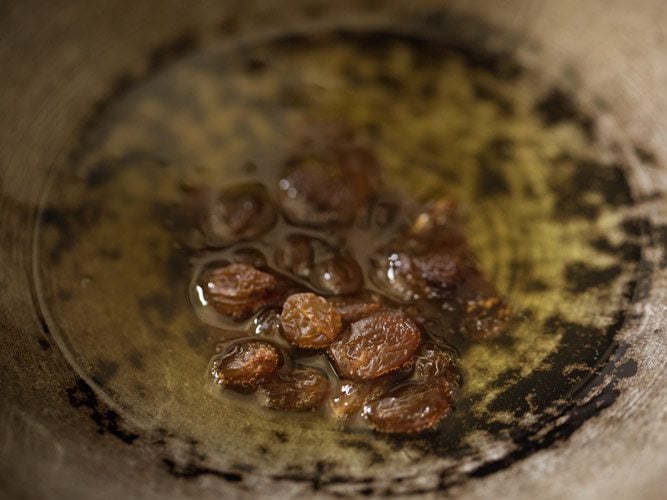
4. Fry the raisins on low heat. The raisins will soon start to swell up. Stir often while frying.
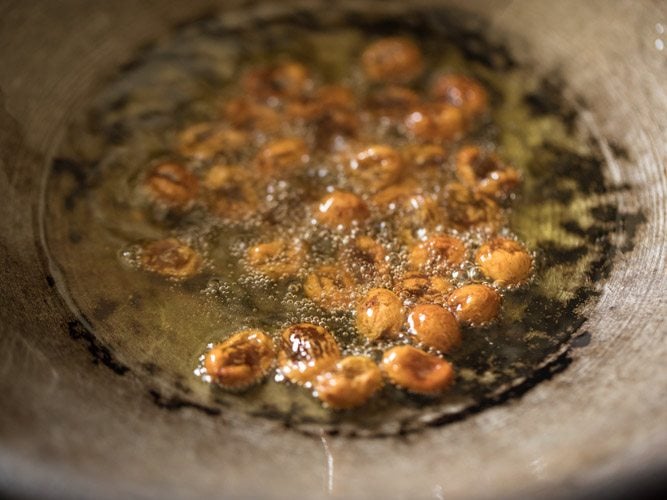
5. Once the raisins swell, remove with a slotted spoon.

6. Keep the raisins aside with the fried cashews.
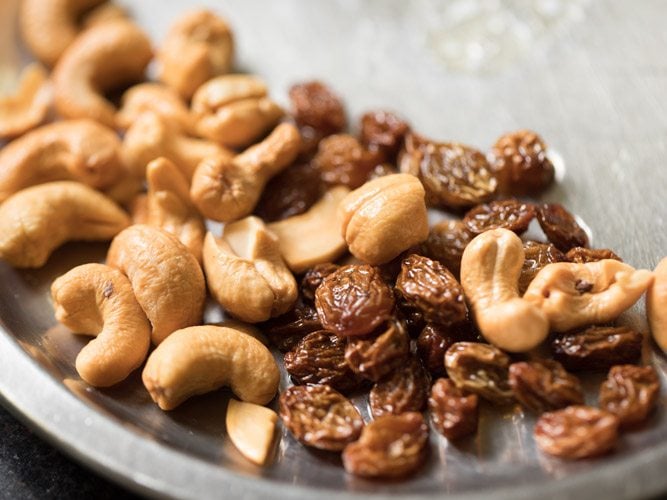
Roast Semiya
7. Before you begin roasting semiya, you may have to break it with your hands if you are using the longer variety. This makes it easier for you to stir while roasting.
In the same kadai, add 1 cup broken semiya (seviyan or vermicelli).
Tip: The semiya can be made of whole wheat flour (atta), rice flour, all-purpose flour (maida) or rava/suji (cream of wheat). In this recipe, I have used whole wheat flour semiya. If you have pre-roasted semiya, then too I would suggest to roast it lightly.
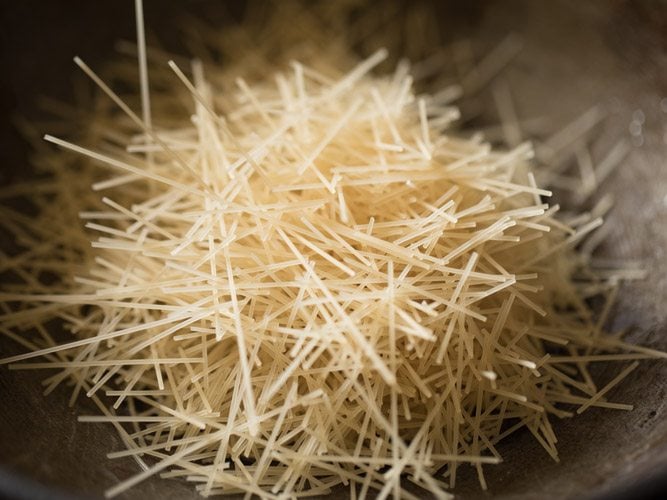
8. Mix well. Keep the heat to low and begin to roast the semiya, stirring often.
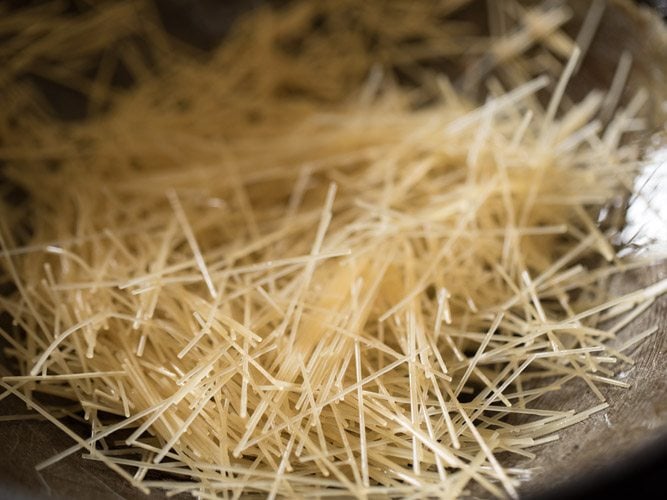
9. Roast until the semiya turns golden. Stir often for even browning and so that the semiya does not burn.
These get cooked fast, so do not leave them unattended.
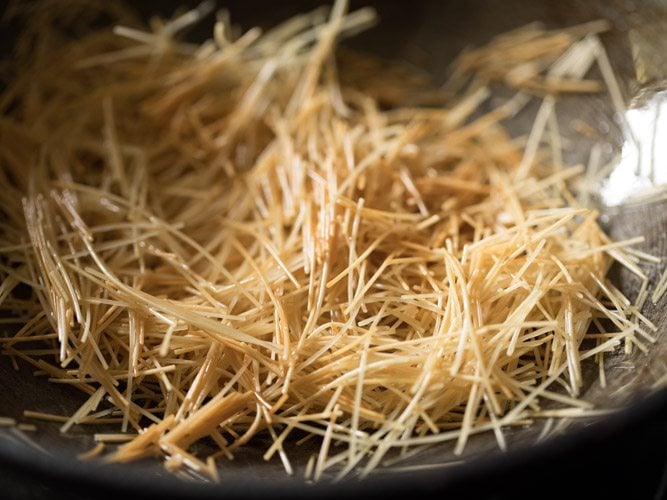
Make Semiya Payasam
10. Once the semiya turns golden, add 3.5 cups whole milk.
Milk can be chilled, hot or at room temperature. For a thin payasam, you can add 4 cups milk.
Note: On cooling, the payasam thickens. So, add milk according to the consistency you prefer.

11. Mix very well.
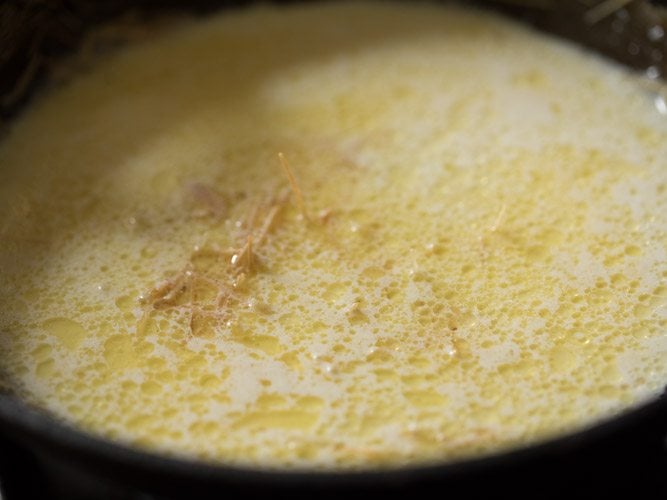
12. Keep the heat to low or medium-low and simmer till the semiya strands soften.
Stir at intervals, so that the milk or semiya does not stick or get burnt at the bottom of the kadai or pan.
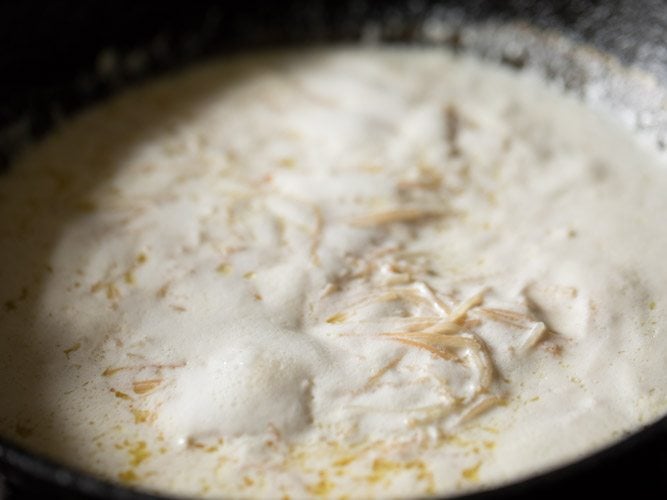
13. Simmer until the semiya strands are softened and have cooked well.
Scrape the sides of the kadai where milk solids will be collected and add them into the payasam.
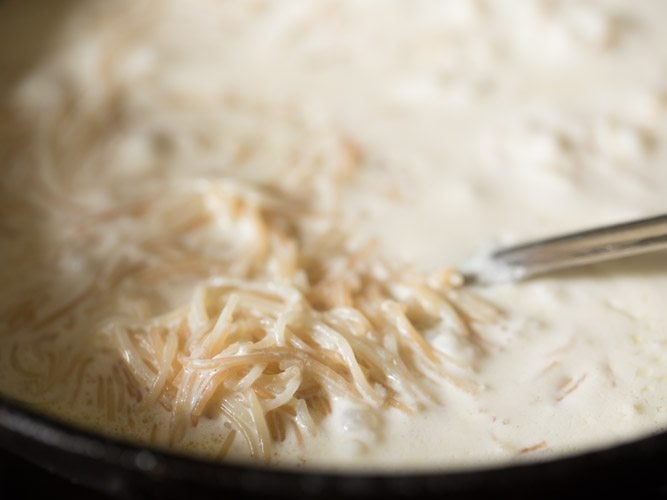
14. When the semiya strands have nicely softened and are tender, add 4 tablespoons sugar or according to the desired sweetness.
4 tablespoons sugar works perfectly for us. If you want a sweeter payasam, add more sugar.

15. Add ½ teaspoon cardamom powder.
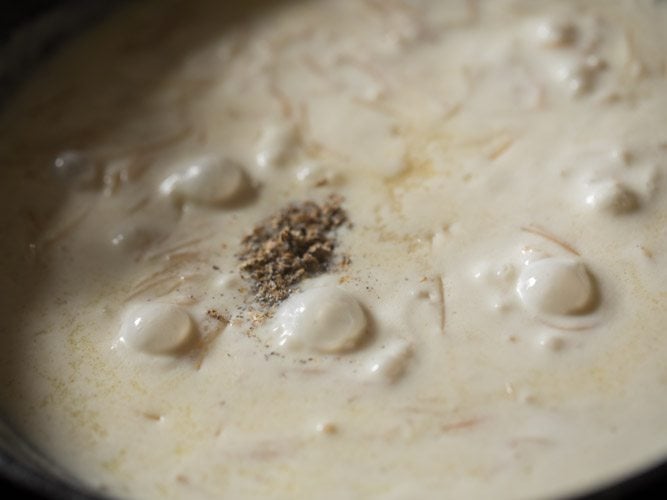
16. Mix very well and simmer Vermicelli Payasam on low to medium-low heat for 2 to 3 minutes more. The sugar should dissolve.
Taste and add more sugar, if needed. Take a note of the consistency you prefer as the payasam will thicken once it cools.

17. Turn off the heat and add the fried cashews and raisins.
You can even keep a few raisins and cashews for garnishing.
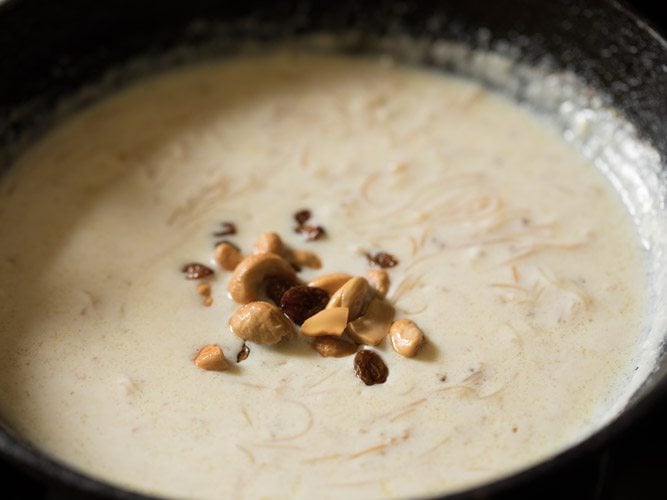
18. Serve Semiya Payasam hot or warm, garnished with reserved fried cashews and raisins.
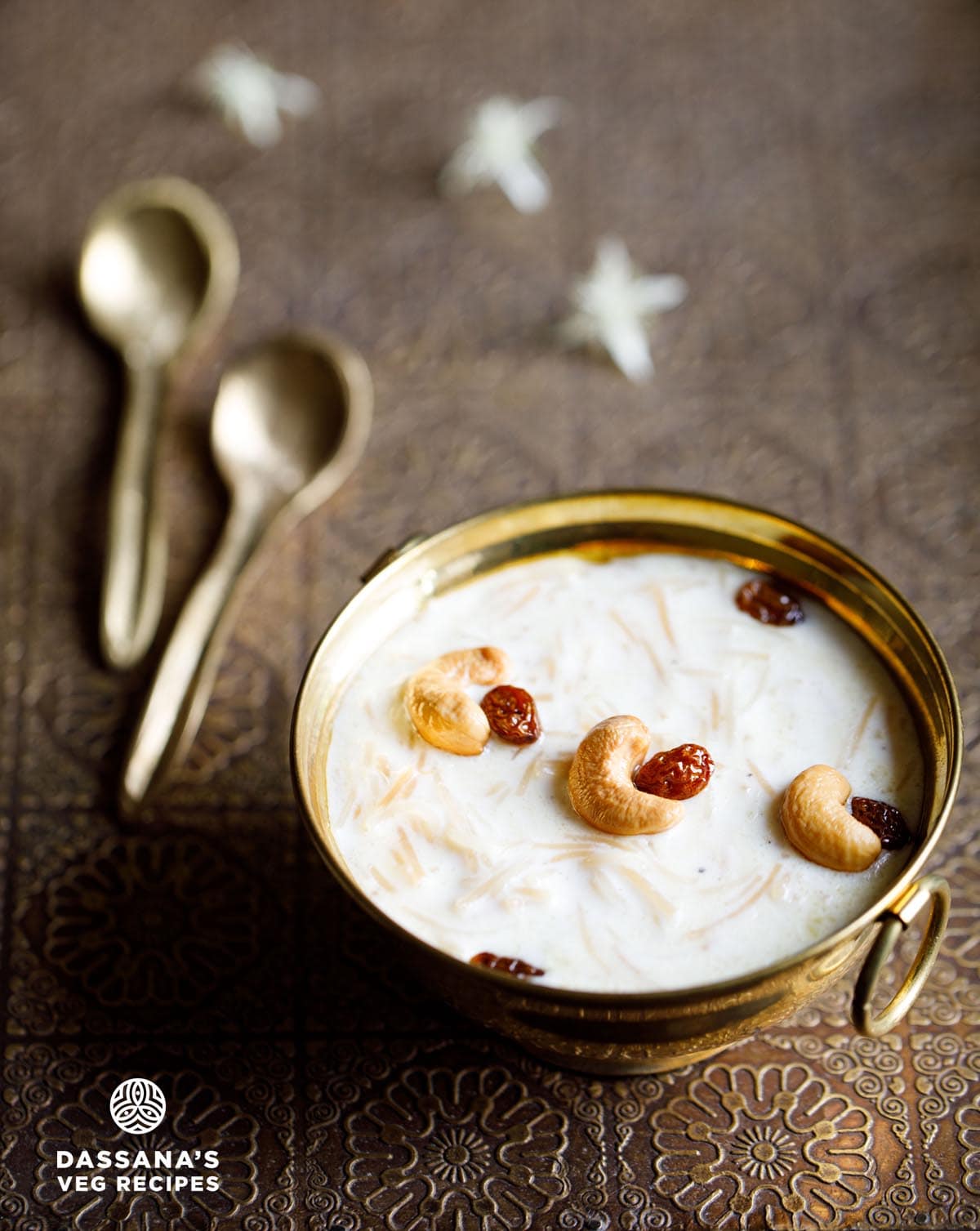
Serving Suggestions
You can relish the flavors of this fantastic Vermicelli Payasam by serving it hot, warm or even chilled. When it cools to room temperature, then you can refrigerate and serve later as a chilled sweet pudding, if you prefer that.
But remember, on cooling and refrigerating, the Semiya Payasam thickens. Thus, keep it to a slight flowing consistency, if you want to serve it chilled. So that it does not thicken too much. If at all it does, then simply add a bit of milk to thin the consistency while serving.
Storage
If there are any leftovers, then refrigerate for 3 to 4 days in a covered container. I would not recommend freezing as the taste and texture changes and becomes way off.
After refrigeration, you can reheat the payasam on low heat, if you want to eat it hot or warm. Add some milk or water if the consistency has thickened too much.
Expert Tips
- Vermicelli: Like I said earlier, make this payasam with any type of vermicelli – whole wheat, rice, all-purpose flour, semolina, various millets or ragi (finger millet).
- Milk: For a rich creamy payasam, I suggest to make it with whole milk. If you are looking for low-fat options, then consider making it with low-fat milk or toned milk.
- Sweeteners: Payasam is made both with sugar and jaggery. Sugar can be added less or more as per the requirements.
- Nuts: Traditionally, this recipe has cashews and raisins. You can also add your choice of nuts and dry fruits.
- Flavorings: Cardamom powder is the preferred choice of spice in this payasam recipe. You can also add a few saffron strands.
- Serving to deities: If serving to deities, add a pinch of edible camphor after the payasam is cooked.
- Cooking payasam: Slow simmering is the key to make a good payasam. So, remember to slow-cook, so that you do not end up with burnt patches of milk or a thick gloppy payasam.
- Consistency: For a thicker payasam, add less milk and for a thin payasam, add more milk. If the payasam becomes too thick after cooling, simply add some milk to lighten it.
Instant Pot Semiya Payasam
Any payasam can be made in the Instant Pot. Follow the steps listed below to make this Vermicelli Payasam in your IP. Use the same proportions of ingredients as mentioned for the stovetop recipe.
- Frying nuts: Press the sauté button of the IP. When you see the ‘hot’ display on the screen, add ghee. Let it melt. Add the cashews and stirring often, fry until golden. Remove and keep aside. Tip in the raisins and fry until they swell. Remove and set aside.
- Roasting vermicelli: Add the vermicelli. Stirring continuously, roast until golden. If the heat becomes too much, then press the sauté button to get the ‘less’ option.
- Pressure cooking: Add milk and sugar. Close the lid and position the pressure valve to sealing position. Press the porridge button and set the time to 7 minutes on high pressure. When the cooking is done (after you hear the IP beep), give a quick pressure release after 10 minutes.
- Finishing touches: Open the lid carefully. Add the cardamom powder and the fried cashews and raisins. Mix and stir. If the consistency is thin for your liking, then using the sauté function, simmer for a couple of minutes.
FAQs
Both are milk-based sweet puddings – kheer in North India and payasam in South India. Kheer is typically made with milk, while payasam may use milk or coconut milk. In payasam, nuts are usually fried in ghee or coconut oil; in kheer, they’re added directly. Vermicelli Payasam is the South Indian counterpart of Vermicelli Kheer.
For making with jaggery, first cook the Semiya Payasam. Keep aside for 4 to 5 minutes and then only add the jaggery. Use 4 to 5 tablespoons chopped jaggery or jaggery powder.
Adding jaggery to hot boiling milk will curdle it. If you are using coconut sugar or palm jaggery (palm sugar), follow the same method as that of adding jaggery.
If jaggery has impurities, simmer it in 2 tablespoons water on low heat for 3 to 4 minutes. Filter and add this jaggery solution to the payasam.
Almond milk and coconut milk work perfectly. But the cooking method is different. Fry the cashews, raisins in coconut oil or neutral oil. Roast the vermicelli in the same oil.
Add water just enough to cook the vermicelli. When the vermicelli softens, add 2.5 to 3 cups of coconut milk or almond milk and raw sugar. Lightly warm or heat vermicelli payasam. Do not boil. Finish with cardamom powder and the fried cashews and raisins.
Easily make a big batch of this payasam recipe for special religious or festival occasions to feed a crowd.
More Indian Dessert Recipes To Try!
Please be sure to rate the recipe in the recipe card or leave a comment below if you have made it. For more vegetarian inspirations, Sign Up for my emails or follow me on Instagram, Youtube, Facebook, Pinterest or Twitter.
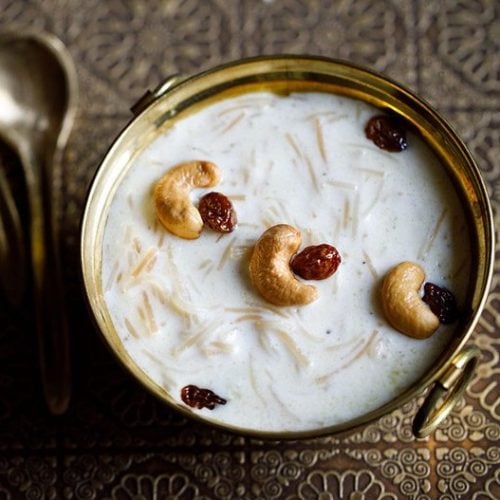
Semiya Payasam Recipe (Vermicelli Payasam)
Semiya Payasam is a creamy, fragrant, sweet vermicelli pudding from the South Indian cuisine. It is made with roasted vermicelli (also referred to as semiya), milk, sugar, and flavored with cardamom. It is often garnished with cashews and raisins fried in ghee. This cardamom scented Vermicelli Payasam recipe comes together in 20 minutes and can be made by beginners too. I share both Stovetop and Instant Pot method to make this decadent sweet.
Prep Time 5 minutes
Cook Time 15 minutes
Total Time 20 minutes
Prevent your screen from going dark while making the recipe
Frying dry fruits (stove-top method)
In a heavy kadai, add the ghee. Let it melt.
When the ghee melts, add cashews. On a low heat fry the cashews until they become golden.
Remove the golden fried cashews with a slotted spoon and then the raisins.
Fry the raisins on a low heat. The raisins will soon start to swell up. Stir often while frying.
Once the raisins swell, then remove them with a slotted spoon.
Set the raisins aside with the fried cashews.
Roasting semiya (stove-top method)
In the same kadai add the broken semiya (seviyan or vermicelli).
Mix well. Keep the flame to a low and begin to roast the semiya stirring often.
Roast until the semiya becomes golden. Stir often while roasting semiya for even browning.
Making semiya payasam (stove-top method)
- When the semiya has turned golden, add 3.5 cups milk. Milk can be chilled, warm, hot or at room temperature. For a thin payasam, add 4 cups milk. Do note that on cooling the payasam thickens. So add milk accordingly.
Mix very well.
- Keep the heat to a low or medium-low and simmer until the semiya softens and are cooked well.Do stir at intervals so that the milk or semiya does not stick or get burnt at the bottom of the pan or kadai.
Simmer until the vermicelli strands are softened nicely.
Then add sugar. You can add less or more sugar according to your desired sweetness.
Sprinkle the cardamom powder.
Mix very well and simmer on a low to medium-low heat for 2 to 3 minutes more. The sugar should dissolve.
Turn off the heat and then add the fried cashews and raisins. You can even keep a few of the fried raisins and cashews as a garnish.
Serve Semiya Payasam hot or warm.
Instant pot method
Press the sauté button of your IP. When you see the “hot” display on the screen, add ghee. Let it melt.
Add the cashews and stirring often fry them until golden. Remove and set aside.
Tip in the raisins and fry them until they swell. Remove and set aside.
Add the vermicelli. Stirring non-stop roast them until golden. If the heat becomes too much, then press the sauté button to get the “less” option.
Add milk and sugar. Give a good stir.
Close the lid and position the pressure valve to sealing position. Press the porridge button and set the time to 7 minutes on high pressure.
When the cooking is done (after you hear the Instant pot beep), give a quick pressure release after 10 minutes.
Open the lid carefully. Add the cardamom powder and the fried cashews and raisins. Mix and stir.
If the consistency is thin for your liking, then using the sauté function, simmer for a couple of minutes until the consistency thickens a bit.
Serving Suggestions
Semiya payasam can be served hot, warm or chilled. When it comes to a room temperature, then you can refrigerate and serve later if you prefer that.
- On cooling and refrigerating payasam will thicken. So keep it to a slight flowing consistency when you want to serve it cold, so that it does not thicken too much. If at all the payasam has thickened too much, then simply add a bit of milk to thin the consistency.
Storage
If there any leftovers, then refrigerate for 3 to 4 days in a covered container. I would not recommend freezing as the taste and texture changes and becomes way off.
After refrigeration, you can reheat the payasam on low heat if you want to eat it hot or warm. Add some milk or water if the consistency has thickened too much.
- Jaggery: Add jaggery after the payasam cools slightly (after 4 to 5 minutes) to avoid curdling. If using coconut sugar or palm jaggery, follow the same method.
- Vegan Option: Swap dairy milk for almond or coconut milk. Fry the cashews and raisins in coconut oil, and cook the vermicelli in enough water. Strain the cooked semiya if there is extra water. Add the milk and raw sugar, heat gently—don’t boil.
- Adding Sugar: Make sure to add sugar after the vermicelli strands have softened well, when cooking in a pan on the stovetop.
- Consistency: Adjust milk for a thicker or thinner payasam. Reheat with extra milk if it thickens too much. For a lighter version, replace 1 cup of milk with water in the recipe.
- Scaling: Easily scale up for large gatherings or festivals.
- Serving Tip: Add a pinch of edible camphor if offering to deities.
Nutrition Facts
Semiya Payasam Recipe (Vermicelli Payasam)
Amount Per Serving
Calories 473 Calories from Fat 126
% Daily Value*
Fat 14g22%
Saturated Fat 7g44%
Polyunsaturated Fat 1g
Monounsaturated Fat 1g
Cholesterol 34mg11%
Sodium 196mg9%
Potassium 385mg11%
Carbohydrates 77g26%
Fiber 1g4%
Sugar 27g30%
Protein 10g20%
Vitamin A 349IU7%
Vitamin B1 (Thiamine) 1mg67%
Vitamin B2 (Riboflavin) 1mg59%
Vitamin B3 (Niacin) 1mg5%
Vitamin B6 1mg50%
Vitamin B12 1µg17%
Vitamin C 1mg1%
Vitamin D 3µg20%
Vitamin E 1mg7%
Vitamin K 2µg2%
Calcium 255mg26%
Vitamin B9 (Folate) 13µg3%
Iron 1mg6%
Magnesium 44mg11%
Phosphorus 301mg30%
Zinc 1mg7%
* Percent Daily Values are based on a 2000 calorie diet.
Semiya payasam recipe from the archives was first published on August 2017.

